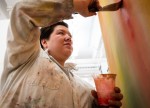This post was updated Nov. 28 at 7:37 p.m.
Hanging cribs, smells of soap and bright neon paintings craft the New Wight Gallery’s newest exhibit.
The art pieces are featured in the Undergraduate Scholarship Award Exhibition, which opens Thursday. The exhibition will showcase artwork by the undergraduate students who received UCLA Department of Art and School of the Arts and Architecture scholarship awards for the current school year. Around 50 students were nominated by the art department, and out of that, 33 received the scholarships. Recipients submitted and created pieces ranging from socially conscious installations that comment on an artist’s experience of the foster care system to abstract, bright paintings that almost look like hair. A few of the artists spoke to the Daily Bruin about their projects, processes and inspirations.
Angel King
Angel King waxed pairs of underwear to make them transparent and solid.
The fourth-year art student then wove the underwear through a crib that she hung from the ceiling. The installation, titled “Jellyhead,” inverts common bedroom items to convey her own unease growing up in the foster care system.
Fourth-year art student and fellow exhibition artist Lorena Ochoa said King is able to relay her turbulent past through a piece that evokes unease and tension in viewers in its clear connection to her past trauma. King said she strives to make viewers feel fearful or anxious seeing her work.
“You can get a physical reaction from making it and from people seeing it,” King said.
Below the crib, King turned a dresser on its side and stacked books on top, finishing off the pile with her family’s photo album. One of the ways she hoped to induce anxiety was placing the dresser on pins and needles and hanging the crib above viewers, which she said constructs an edge of danger in the work without risking the safety of viewers. She also hung a pink baby blanket with floral print and stickers on the wall to contrast with the dresser.
“I try to straddle this line of beautiful but also … dangerous,” King said. “I like to be on opposite sides of the spectrum.”
Francine Banda
Some of the pieces in the exhibition are products of concrete ideas, but Francine Banda’s work is improvisational, she said. The fourth-year art student will display two untitled paintings at the exhibition. With sizes of 6-by-6 and 8-by-10 feet, the paintings reflect Banda’s fluctuating social anxiety.
“It’s more about transcending motive, kind of like evoking emotional response,” Banda said. “It’s like a documentation of subconscious thought or repressed emotions.”
Banda starts with a base color and layers different colors on top, alternating between more diluted and opaque textures. Though her painting method is an intentional process, the layers of paint create shapes Banda does not deliberately intend to represent real-life objects. One painting has a base color of pastel blue layered with other blues, greens and pinks. The final composition of paint alludes to tendrillike shapes, almost like hair.
Her largest painting for the exhibit features lime green, yellow and pastel purple paint with splotches of dark maroon. The large paintings require Banda to use her entire body to move between spots, but she actually finds them easier for her to complete due to the lack of spatial constraint, she said. King said the size of the painting along with the vivid colors creates an all-encompassing effect of viewers’ immediate surroundings.
“It’s almost like you’re enveloped inside this bright color with all of these forms,” King said.
Lorena Ochoa
Ochoa utilized household materials, such as soap and tablecloths, to comment on the racial, class and gender oppression Chicana women can face.
She said she recast the commonplace objects to evoke recognition of a blue-collar lifestyle. Ochoa said the objects’ clear connection to working-class people helped highlight the marginalization of lower-income communities, and other elements of her art, including auditory and olfactory features, emphasize the disadvantaged position of some Chicana women in society.
“A lot of my work comments on the lower-class marginalized experience in a capitalistic Anglo society and …. speaks towards the triple oppression of Chicana women,” Ochoa said.
For Ochoa’s “Los Desperados y Desesperados,” she stitched together photographs of a 20th-century Western cowboy and a current-day migrant caravan. She then hand stitched the made-up word “Desperado,” which comes from the Spanish word for “desperate,” into the top of the piece. Finally, she rephotographed the composition and edited the coloring of the new photograph. The caravan in the corner of the photograph and jaggedly torn edge implies how Western American cowboy culture causes the current political climate.
Ochoa’s painting “Paradox of La Niña Fresa” included casts of lamb chops on a wallpaper she painted over to deconstruct the domestic imagery of household items. A clear tablecloth with strawberry designs is layered over the painting – similar to saran wrap – to finish the reassembly of domesticity.
For her third piece, “De Ladrando y Ladrillos,” Ochoa created 184 casts of a Mexican soap brand, called Zote, and arranged them on a wooden board to mirror the pattern of a brick wall. The wood is infused with the smell of the Zote soap to engage the sense of smell, while audio from Gloria Anzaldúa, a Chicana feminist, plays in the background, discussing the challenges of being a part of multiple cultures.
“I want to disrupt people’s normal view of mundane objects,” Ochoa said. “I feel like there’s power in the mundane.”
